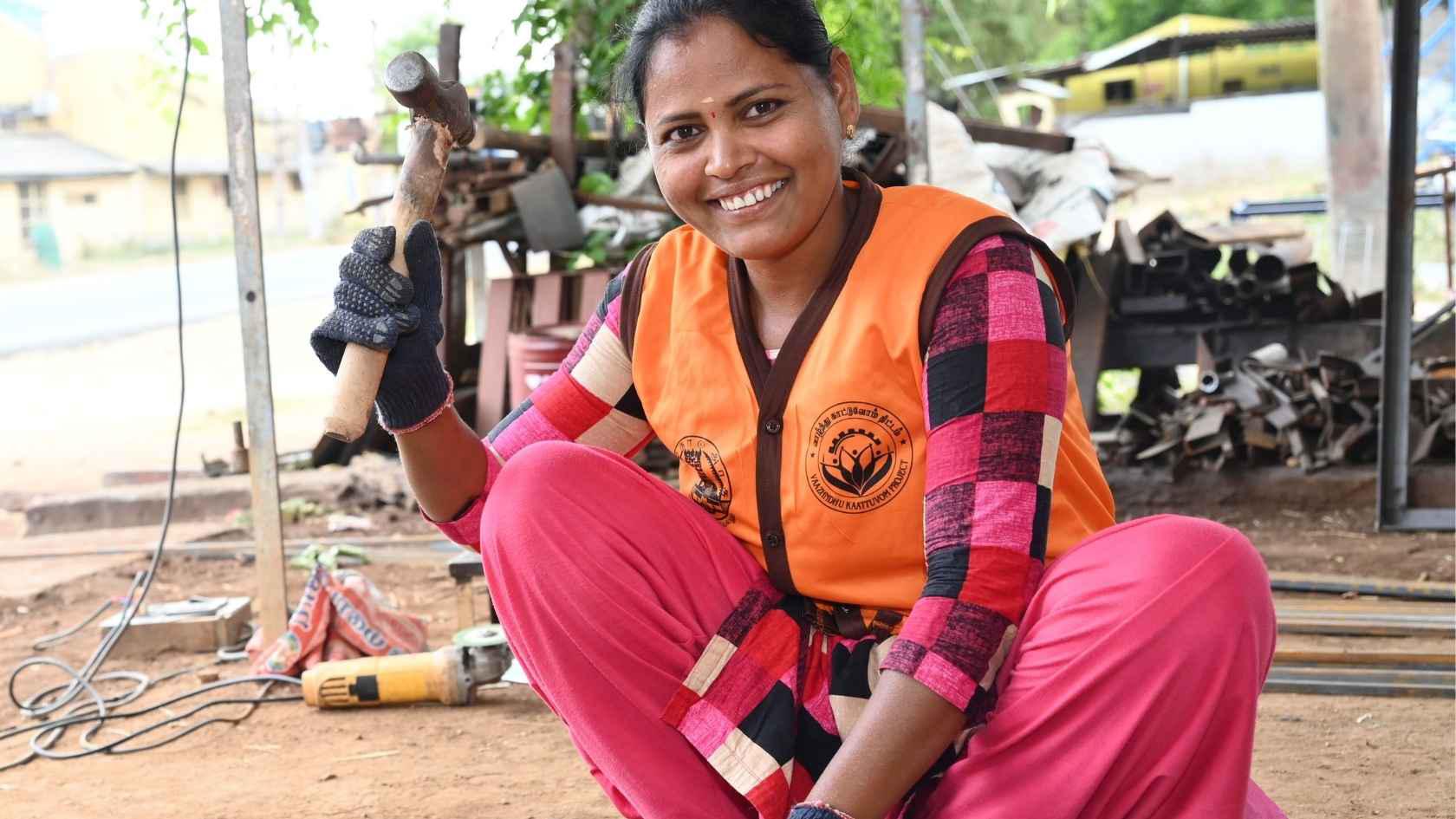Taxing Times: Mobilizing Revenues in South Asia

- ABOUT THE EVENT
- transcript
GO TO: SPEAKERS
Amidst a challenging global economic environment, how can mobilizing domestic revenues help the South Asia region build buffers against potential shocks?
Experts from the region explored tax reform strategies to boost revenue and support sustainable growth across South Asia. They discussed the latest edition of the World Bank’s South Asia Development Update, Taxing Times, which outlines how targeted reforms can strengthen fiscal positions and deliver substantial economic gains.
Join the conversation on social media #SouthAsiaDevelopment
[Fahmida Khatun] Good morning, good afternoon, good evening to you depending on where you are. It is my absolute pleasure to welcome you to this program today, including the audiences watching World Bank Live, Facebook and X/Twitter to this very important event which is on “Taxing Times: Mobilizing Revenues in South Asia”. Let me start with a short context of the event. As many of you know that the South Asia Development Update is the World Bank’s flagship semiannual report for South Asia, which assesses growth prospects for the region and individual countries and analyzes topical economic policy challenges. The 2025 edition of the report, titled “Taxing Times,” says that South Asia’s growth prospects have weakened amid uncertainty in the global economy, so regional growth is projected to slow to 5.8% in 2025, which is 0.4 percentage points below October projections. Multiple shocks over the past decade have left South Asian countries with limited fiscal buffers. Stepping up domestic resource mobilization could help this region strengthen fragile fiscal positions and increase resilience against future shocks. Although tax rates in South Asia are often above the average in developing countries, most tax revenues are lower. This report recommends a range of policies to improve the tax revenues by eliminating loopholes, streamlining tax codes, tightening enforcement, and facilitating tax compliances. So, this event will be part of the launch of the report, bringing together experts from the region to discuss how South Asian countries can implement targeted reforms to strengthen fiscal positions and reap large economic gains. The format of a program will be as follows: You will have a 60-minute virtual event hosted by World Bank Live, the World Bank’s flagship public event streaming platform. The event will also be broadcast through the World Bank South Asia Facebook and Twitter/X channel. This event will be opened with a fireside chat followed by a moderated panel discussion. I have the pleasure to moderate the session and I would like to now request the audience to interact through the hashtag #SouthAsiaDevelopment. This is #SouthAsiaDevelopment and please post questions online through the World Bank Live chat window. Before I go to the fireside chat, let me also just introduce myself. I am Fahmida Khatun. I am the Executive Director of the Center for Policy Dialogue, which is a think tank in Bangladesh, and I have the privilege and honor to moderate the session. But before I go to moderate the session, let me start with this fireside chat which will be participated by two distinguished guests. I would now hand over to Martin Raiser who is the World Bank Vice President for South Asia. He will be speaking with Muhammad Aurangzeb who is the Federal Minister for Finance and Revenue, Government of Pakistan. Over to you, Martin.
[Martin Raiser] Hello everybody. This is Martin Raiser, Vice President of the World Bank in South Asia. I have with me today a very special guest, the Minister of Finance of Pakistan, Mr. Aurangzeb. A warm welcome to you, Minister. In this spring edition of the South Asia economic update, we are focusing on the issue of revenue mobilization. That’s because South Asia doesn’t collect enough revenues to finance all of the public investments and social services that people aspire to. South Asia collects only 18% of GDP in taxes on average. In Pakistan it’s only 9%. The average emerging market achieves 24%. So, there’s a gap of 6 percentage points, and that puts reforms to increase the efficiency of tax collection very much in focus because it’s not that tax rates in South Asia are too low, it’s that too few people pay relatively high taxes. So, Minister, I want to talk to you about this. You have been spearheading an effort of tax and administrative reform in Pakistan with the support of the World Bank and the IMF. I would be interested in hearing from you. In your vision of increasing revenue collection as you have targeted from 9% of GDP to 13% of GDP, what are your priorities?
[Muhammad Aurangzeb] So, Martin, first of all, it’s a pleasure to be here and you’re absolutely right in terms of what you have just said. Pakistan as a country has been languishing in terms of tax to GDP ratio. There have been ups and downs, but anywhere between 9% to 10%. That in itself has led to a non-sustainable fiscal position and situation that you referred to. In fact, for the longest time the bane of the country has been twin deficits. So, while current account surplus is a good discussion this year round, but the primary surplus which is now there on the fiscal side is because we’ve decided to go and move the equation towards 13.5% during the course of the program. This year, when we close at June, we will be around 10.6%. So, it’s a good journey over the last 12 months and it’s about 1.6%, 1.7% delta. We still have a long way to go, but at least it’s moving in the right direction. And from my perspective, the country’s perspective, while that’s what we’ve agreed with the Fund, we’ve really been supported by the World Bank Group through your technical support. It’s the right thing to do for the country because anything you just mentioned, and you gave the world averages, etc. 13.5% will just bring us into a comity of nations and start moving us towards a modicum of fiscal sustainability. So, we are very laser focused on this and if you would allow me, I will just expand on how part of the journey that we are on.
[Martin Raiser] Yeah, please. I mean it’d be great. There’s always this discussion. Do you do it through tax policy? You raise rates, do you tax new sectors? I mean in Pakistan long discussions about real estate, about land, about retail, or is it just the efficiency of collection, the introduction of e-filing, for example, the efficiency of tax administration? What are some of your priorities? How did you do it? Even the progress you’ve made so far.
[Muhammad Aurangzeb] Martin, as you know we have known the what and the why for the longest time in Pakistan. So, that’s not an issue. There’s no dearth of policy prescriptions, it’s just the “how” part of it and the “who” part of it. We just haven’t done it. This time around we are very focused on two key tracks, if you want to call it that. One is to bring those segments which are contributing significantly to the country’s GDP but really are not giving anything in turn back to the exchequer. [Martin Raiser] Right. [Muhammad Aurangzeb] The areas that you have mentioned which are real estate, wholesale, retail and agriculture, again as I said, we have a long way to go. But in the country’s history this is the first that agriculture income tax has been legislated through the provincial assemblies. A lot of people say okay, a lot of skepticism to start with, in terms of whether you will be able to do it or not. And there I’m very grateful to the Provincial Chief Ministers because as you know we have to work with the provinces. We’re moving in the right direction in terms of bringing these segments in because, if we don’t, what is the option that we have? We keep on going back to the same for more, which is the formal sector in terms of the manufacturing industry and the salary class. And the reality is they’re both up to here. We have squeezed every possible thing that we could have. So, by definition we have to expand the neck. That’s the journey that we are on. That’s one part of it. The other part of it is just the transformation of the tax authority, people, process technology. Why do I say that? It’s because you have to have credibility in the tax authority of the country and year-round trust. I mean I can tell you there are people, there are segments who came to us and said, “We will give you more tax if that’s what you need, but we don’t want to deal with the authority”. Now, that is not sustainable. Probably Pakistan, and I’m being very open about it, probably is the only country where we came up with and coined the term non filer, which means I don’t have to file my taxes, but I pay a penalty or pay a premium and I can go ahead with my lifestyle in terms of transaction into property transactions, into buying cars, etc. We have done away with that because it’s about time that we request our netizens and citizens that they have to come into the net, but the flip side is also equally important, that we enable the authority to bring that mutual trust and respect. So, we have changed people, we have changed the incentivization structures, we have brought in auditors because that’s not a core competence of the authority itself. Processes, simplification of the processes, this is work in progress. This has not happened yet, Martin, but I do want to mention that very quickly. 70%, 80% of the salary class, they get money in their account, the tax is deducted at source. They still have to fill out forms which I don’t even understand. 140, 150 fields, we are bringing that form down to about 9 to 10 fields, about 5 fields onto the wealth side, about 4 fields onto that side. The bulk of it is also auto-filled. Now, the balance, 15%, 20% who have fixed income portfolios, equity portfolios, well, they’ll have to still go with the rigmarole. But if we go in that direction, that, in my view, will again help us with the communication strategy that we are trying to facilitate the taxpayers in the country. The last thing which is technology is the end-to-end digitalization, which is extremely important because we’re trying to reduce the human intervention, bringing in more transparency, reducing the leakage, which is quite frankly a euphemism for corruption. AI led audits, we have digital enforcement in terms of the value chains brought back, the track and trace system in terms of the largest sectors with sugar, with fertilizer, with tobacco in on the custom side, we call it “faceless customs.” We have broken the nexus between the importer and the customs person who previously knew what was being targeted and brought in. With that out of the way, the goods clearance time period has gone down by 80% and the revenues have actually gone up by 16%. It’s a long answer Martin, but I thought I would explain the “how” part of it because that is very important, the segments and the technology part of it.
[Martin Raiser] No, I think you mentioned a lot of things that I would have asked you anyway, so I’m glad you mentioned them. One thing you didn’t mention, that you also separated tax policy and tax administration. One of the remarkable things that we find in a lot of tax codes in the region is the multiplication of exemptions. In some jurisdictions, exemptions can be written by the tax collectors that are supposed to collect the taxes. You can see how that opens a lot of avenues for leakage, but you’ve done away with that. What other ideas do you have on the tax code side in terms of reducing exemptions, simplifying the tax code? You talked a bit about administration, you talked a bit about using digitalization, end to end digitalization to improve collection. On the tax policy side, are there any plans in addition to bringing the real estate, the retail and land into the tax net?
[Muhammad Aurangzeb] Let me just address the first point because it is a huge structural shift and the cabinet approved that the tax policy office moves across into the finance division, so that FBR is really focused on collection. During this year, we have quite frankly, and we’re very grateful to the World Bank because you helped us with analysts who have… You are looking in terms of the budget proposals that should come in and giving us independent advice, what makes sense, what doesn’t make sense in terms of international benchmarks, etc. But the reason why the tax policy office has been moved across, and by the way, it has been very well received in the country and by the industry, and for the very simple reason that that should be led by economic value considerations. What we have been doing in the yesteryears, at the time of the budget, we essentially see how to make the math work and making the math work is important, but the disruption that it creates for local and foreign investors in terms of when they come in, they invest with a medium-term view in life. If you go and start poking holes in terms of what had been committed and you start adding additional things and additional taxes, obviously that disrupts their business and revenue models, etc. So, that is the reason why I’ve gone in that direction and I do think it’s going to be very important in terms of, again, the fiscal sustainability part of it. The simplification, I’ve just told you a little bit of the processes, but we will do a complete review end to end in terms of what and how we can… Because ultimately, it’s how you want to facilitate the taxpayers, not by making and adding more complications to the code itself. So, that process is underway at this point in time, Martin, but we are not there yet.
[Martin Raiser] Right, right. You already answered another question that I had for you, which is the instability of the tax system from a private investor perspective. You would know it well because you were in the private sector for most of your career, but that you’re trying to get away with by putting the tax policy division and the finance department and avoiding the sort of micromanagement of rates and exemptions or additions to meet the fiscal numbers and instead have fiscal and a tax policy oriented towards macroeconomic goals at the beginning of the fiscal year and then try and achieve some stability. But I was going to ask you a final question, perhaps, which is related to the political economy of this. I mean, surely this wasn’t easy. So, where were the main obstacles, and perhaps more importantly, how did you manage to overcome them? What was the strategy used? Did you call everybody in and knock their heads together and said you’re not leaving until you agree? Or what was the coalition that was built to make this, to start this journey? I mean, admittedly it’s not yet finished.
[Muhammad Aurangzeb] I certainly don’t want to leave you with the impression that everything is hunky-dory and just. Yeah, I mean, there is obviously pushback from various quarters. The reality is we had to, in some sense, think through a charter of economy and get buy-ins, not only just at the federal level, but as you know, after the 18th amendment, a lot of subjects, a lot of taxation was actually devolved. It was less about me calling people across to Islamabad. It was more the Finance Secretary, myself and the Chairman of FBR actually going to the capital and provinces and sitting down with them. I said earlier as well, I mean, I am very grateful to the chief ministers of the various provinces because I tell you, Martin, there was so much skepticism around two things. One about the national fiscal pact, because that could not have been signed without the provincial support. It has a revenue component, it has an expenditure component, it has a governance component. And then, when it comes to agriculture income tax, this is big. This is really big. And now, of course, we now need to see how we monitor it, how we collect it. That’s where again, the “how” part of it comes in, Martin, because we have now reactivated the National Tax Council. I chair it at the federal level. The provincial finance ministers are members of the National Tax Council. This is about alignment of taxation between the federation and the provinces, but also where we bring up discussions, debates as to what should be happening and how should we align our thought processes. Because real estate being a case in point where we have imposed certain taxes, and the provinces have certain taxes. I’m just putting it out there, whether collectively we have taken the transaction cost to a certain level and maybe too high. These are the kind of discussions we will have as we go forward with respect to the federation. That’s a great forum because the buy in comes in through the consultative process and that is our way of institutionalizing a forum. The Finance Secretary will chair another forum at the executive level and that will feed into the National Tax Council. So, a lot of building blocks have been put into place over the last 12 months. I do want to appreciate all the support that we are getting from the World Bank because we are always very grateful for the funding and the financing, but the technical support is absolutely critical in terms of, from our perspective, what is some of it is uncharted territory. With that support, I’m sure we have to stay the course.
[Martin Raiser] Thank you very much, Minister. You’ve already done 1.6% out of the 4 percentage points in the first year of this administration. We very much hope that you reach your goal before the end of the current mandate of the government. We are certainly happy to continue to support you on this. And with Pakistan, this would be a second case of a reasonably successful revenue-based consolidation. Sri Lanka has just gone through the first phase of it. The key challenge is going to be after that to use fiscal policy to relaunch the growth effort and make sure that the region grows out of its debt problems because as we know, doing it just from the revenue side is not sufficient, but it’s a great start. Thank you so much, Minister, for sharing these thoughts with you, and we’re wishing you a very good trip back.
[Muhammad Aurangzeb] Thank you, and thank you for your partnership.
[Martin Raiser] Thank you so much.
[Fahmida Khatun] Thank you very much, Martin, for that insightful discussion. Now I would turn to my panelists. We’ll have a panel discussion for the next half an hour or so. We’ll hear from three very distinguished discussants. Let me just first introduce them very briefly. They’re all very distinguished in their own capacities. We have Mr. Shiran Fernando, who is the Chief Economic Policy Advisor of Ceylon Chamber of Commerce, Sri Lanka. Very briefly, I mean, he has a stellar CV. Very briefly, he is the Chief, as I’ve mentioned, that he’s the Chief Economic Policy Advisor at the Ceylon Chamber of Commerce and also a former Chief Economist leading its Economic Intelligence Unit. He was a Chevening Scholar, U.S. IVLP Alumni and also an Australia Awards recipient. Shiran is a monthly columnist for LMD and serves as a member of the board of World Vision Lanka and University of Vocational Technology and formerly Petroleum Development Authority of Sri Lanka. Next, we have Mr. Khurram Husain. He is the Business and Economy journalist of Dawn and Mr. Khurram has also a stellar CV to his credit, he has taught at the prestigious Lahore University of Management Sciences in the past. He writes a widely read column in Dawn, Pakistan’s leading English language newspaper, and in television has been a contributor to BBC providing short features on economic issues as well as appearing as an analyst for English and Urdu languages in Pakistan. He was the Pakistan Scholar at the Woodrow Wilson Center between 2013 and 2014. Then we have Franziska Ohnsorge. She is the Chief Economist for the South Asia region of the World Bank. Franziska, in her role she’s responsible for leading the research program on key economic issues in South Asia to inform the policy debate and World Bank lending. Before starting this position, she was the Manager at the Development Economics Vice Presidency where she spearheaded the flagship Global Economic Prospects Report. Prior to joining the World Bank, Franziska worked in the Office of the Chief Economist of the European Bank for Reconstruction and Development and at the International Monetary Fund. She has several write ups which have appeared in peer-reviewed journals as well as many policy publications which have been widely covered across the world. She holds a PhD from the University of Toronto. So, as I have mentioned that these three distinguished scholars will provide their perspectives on tax issues, I would start with Franziska, so I hope to have two to three rounds of discussions depending on the time availability, but let’s start. I would request all the panelists to be precise so that we can have more discussions. So, to Franziska, my first question is that in this edition of the South Asia Development Update Report, you and your team explore the current economic landscape in South Asia, especially amid so much global uncertainty and upheavals. So, why is the issue of domestic resource mobilization so important in this context? And also, what are the challenges in this region when it comes to tax revenues? Could you please elaborate where the major shortfalls are and what do these findings say about the policy? Over to you Franziska.
[Franziska Ohnsorge] Thank you, Dr. Khatun. As you said, South Asia’s growth prospects are dimming and the risks are rising. And in this environment of rising risks, South Asia’s fragile fiscal positions make the region vulnerable to shocks. So, just to give you an illustration of how vulnerable the region is, South Asia is the region with the largest government debt to GDP ratio and with the highest interest spending among emerging markets in developing economy regions. When you have a global financing shock, South Asia is the one that feels it. It hurts. Of course, at the root of these fiscal fragilities are low revenues. Again, to give you a background, South Asia is not only the region with the highest debt and highest interest spending relative to revenues, it’s also the region with the lowest revenues in percent of GDP. The challenge is actually surprisingly common around, across the region. Almost everywhere you look. The problem is high tax rates, low revenues. So, once you control for these tax rates, take into account the relatively high level of these tax rates, you find that the revenue shortfalls relative to what you would expect based on these high tax rates is somewhere between 1% and 7% of GDP with the biggest gaps in consumption taxes and corporate income taxes. Some of that, of course, is just because of the structural features of South Asian economies. They tend to be very agricultural, heavily agricultural. 42% of the population is in agriculture in South Asia. They tend to be very informal. Somewhere between 80% and 90% of the employed are informally employed. That of course makes it difficult to tax these populations, but even when you take these structural features of South Asian economies into account, you control for them. Even then, you find that the structural features can explain no more than half of this revenue shortfall of between 1% and 7% of GDP relative to what you would expect. Which points us to the solution to lower revenues. It seems that exemptions erode the tax base and loopholes need to be removed. And also, simply that the process of collecting taxes, what we call tax administration, needs to be improved. This is something that also came up prominently in the fireside chat that we just heard. This idea that it’s too few people paying too high taxes. So, there is a need to broaden the tax base and improve the collections of whatever tax codes are in effect. Back to you, Dr. Khatun.
[Fahmida Khatun] Thank you very much, Franziska for these points. I think some of these points resonate with the features of, especially in the context of Bangladesh. Also, like you have mentioned that too few people are paying too high taxes. That’s, I think one of the common features in South Asia, in many countries within South Asia. Let me also now hear from Mr. Shiran. So, for you, I had this first question that Sri Lanka has recently launched a series of major tax reforms, including raising corporate income tax on some sectors and imposing value added tax on digital services. So, how is the private sector responding to these tax reforms and what are the main challenges the businesses are facing as governments are shifting their policies?
[Shiran Fernando] Thank you so much for the question and the World Bank for having me on this panel. It’s great to be here. I think to answer your question, I think we have to look at it in three parts. I think the base and the normalization. So, if you look at from the 1980s to about 2000s onwards, Sri Lanka used to collect close to between 15% to 20% of tax revenue when you look at the tax to GDP ratio as well. So, it was coming off a strong base, a lot of social spending for education and health care and other services. But I think we’ve seen since, I think, 2000, a lot of policy changes, in particular on tax policy, a lot of ad hoc taxes coming in, periods where you would reduce tax rates and increase certain thresholds in the hope that the tax net would widen, but didn’t really materialize. Historically, I think, and when the Finance Minister of Pakistan was speaking as well, there were a lot of parallels to Sri Lanka. I mean, one key parallel is Pakistan has been for 24 packages under the IMF. Sri Lanka is closely behind on 17. The key reason is this because of the continuous changes that we’ve had over the last two decades in particular. So, what has happened in the last few years, in particular with the external debt restructuring that Sri Lanka underwent in the last two, two and a half years is, as you mentioned, we looked at some of these tax rates, increased corporate tax rates to what it was or slightly higher, brought back income taxes because Sri Lanka is so much dependent on consumption and indirect taxes, VAT also going up. So, a lot of this got us back from a low base of about 8% of GDP where we fell back to 13%, 14% levels and we’re coming back to what we were. In the last two years we’ve overperformed. I think a lot of estimates and a lot of targets. We’ve hit the primary surplus numbers. So, we’ve done well in that sense. This year in particular, I think the expectation is that growth plus opening up of vehicle imports after five years will give that tax revenue boost. So, the third part is where are we going to go? Can we sustain this? I think this is the critical point for countries in South Asia, in particular Sri Lanka, because this is where we usually go wrong. And then, we end up, again, going back to some level of support from the multilaterals. So, I think there are five things to look at here. I think historically we’ve looked at a lot of income taxes, consumption-based taxes in terms of redoing the tax structure, but maybe we also need, maybe an IMF program or a multilateral program also needs to look at other revenue collection areas such as customs or excise because I think a lot of focus has not come into these areas, that is significant level of leakages happening here as well. I think here we do find the private sector having consensus for reform, in particular of legislation like the customs ordinance that we do have, which can definitely generate much more revenue. Another thing which corresponds with what the Finance Minister mentioned was, of course, widening the tax net and simplifying the process. Now, every private sector forum, this is what you hear. The private sector folks who come, in particular at our chamber, always talk about how they are the ones complying, the burden is on them. However, there is also pressure for them to be more compliant. Whereas there are maybe sections of the informal sector, those who are not in the net, who may not have to really comply. So, how do you get that balance right between not burdening the already set of taxpayers but also managing to widen the net? I think this needs to be done carefully. I think that really comes through a better tax culture or the need to, or the want to be able to pay taxes. So, the social contract, I think empowering that and better prudent government expenditure coming in as well. I think the new government that is in place in the last six months I think has been showing early signs of this. Hopefully, that social contract will naturally improve the tax culture as well. The other two is I think digitalization because I think that is a key part of it. Not only the public service, how the taxes are paid, but also the payment side of it. How do you capture that informal sector into the formal side so that they are part of the whole process? I think that’s something that really needs to fast track. I think the final point is how do we break this cycle, which is we do grow, then we do have some level of balance of payments issues. The exchange rate weakens, debt goes up, interest cost goes up, salaries need to adjust, the public sector salaries need to adjust, and what happens at the end? Revenue news to catch up, and once again, the burden is put once again on raising tax revenue, usually from the private sector sources as well. So, I think breaking that cycle is important for the private sector and things like having a tax policy unit, things like that are somethings that will help governments in South Asia to really look at this from a long-term perspective.
[Fahmida Khatun] Thank you very much Mr. Fernando. Mr. Khurram Husain, broadening the tax net is a serious problem. In fact, this is also a problem in the context of Bangladesh. This report also mentions that Pakistan has faced persistent challenges in broadening the tax base. So, what shapes citizens and businesses’ attitude towards taxation and how can these perceptions be shifted to encourage them to comply?
[Khurram Husain] Well, two things in particular shape the attitudes of citizens and businesses towards taxation. One is the gaps in social service delivery, particularly on health, and education, and law and order, with a lot of people asking what exactly is it that I’m getting in return for agreeing to be part of the tax net. The other is the quality of the experience that one has within the tax net. What Shiran alluded to as well when he talked about the tax culture, very similar issue over here, that the tax system and tax authorities are perceived to have too much discretionary power, that there is too much abuse of this power once you come into the tax net, that there is a great deal of ad hoc tax policy making and there is an overburdening of those who are already within the net in order to generate the next or create the next generation of revenues rather than to broaden the base. So, taken together when citizens ask themselves that once I enter the tax regime, I’m going to have to deal with all of these problems that come when you have to face the tax authorities. In return, what am I going to get from it? As the Finance Minister also pointed out that there is a growing number of people who prefer to just pay the penalty for being a non filer of income tax returns and carry on with business as usual rather than come into the net. I think if anything is going to change, this tax culture will have to change and citizens will need to be made and businesses will also need to feel that superior governance is being delivered against the tax money that they are getting. People ask where is my money being spent once I contribute it in the form of taxes? If they see the money being spent in the form of incentives to specific industries via tax breaks, via giving more tax exemptions, or spending in development projects that are nothing more than vanity projects rather than filtering down to impact the lives of the common citizenry and the environments within which small and medium enterprises have to operate. Until that happens, there is going to be an enduring reluctance to come into the tax net. Fahmida.
[Fahmida Khatun] Thank you very much Mr. Khurram Husain. Very relevant points, I think most for many of the South Asian countries. So, we have dwelled on the current policy and administrative issues. Now, I would like to go to the issue of policy options in the context of these countries, particularly in the context of Sri Lanka and Pakistan. And also, Franziska can shed light on the other South Asian countries. So, let me start with Franziska again regarding this policy issue. So, we see that in your report you have mentioned that in addition to identifying tax revenue shortfalls, there are also the options to improve both tax policy and tax administrations which are very important for improving the tax mobilization. These are important, especially this can be successful in the other regions. So, could you please tell us or inform us some of these success stories which have been successful to meet up the revenue collections and revenue shortfalls and how those are applicable in the context of South Asia?
[Franziska Ohnsorge] Yeah, it’s interesting. Both Mr. Fernando and Mr. Husain mentioned this uncertainty and arbitrariness in policy and administration. So, there’s surprisingly little literature, but we do have, we have looked in our report at some benchmarks. If one wanted to broaden the tax base and improve tax administration, how have other countries done it? So, just to give you one example, two prongs to my answer, one on exemptions and one on tax administration. Just to give you one example of an exemption. It’s not quite the exemption that you are thinking of, Mr. Husain, the exemption for favorite industry. It’s a much simpler exemption. It’s simply the eligibility or the exemption from filing personal income tax rates. In South Asian countries, a person with the average per capita income does not have to file, is exempt from filing an income tax return. In almost all countries, with two exceptions, almost all South Asian countries, a person with the average per capita income doesn’t have to file an income tax return. If you compare that with the average emerging market developing economy is a person with one fifth or less of the average per capita income of that country. So, the exemption even for something as basic as personal income tax is very high in South Asia. That’s on exemptions. On the tax administration, there’s actually a flourishing literature now in the academic literature among academics trying all sorts of experiments on how to improve tax administration. The experiments are often small. They’re simply sending letters inviting delinquent taxpayers to the tax office. It’s not very expensive stuff. They find that in a lot of… These experiments have been conducted around the world. So, this is not something specific to just Latin American or just Africa. This is something that seems to hold everywhere. What they have found, these small exemptions, like sending letters and reminders and prodding nudges, they seem to be able to double revenues among the people who’ve been targeted by these particular experiments. The big picture that we got out of a meta regression of this analysis is that the measures that are particularly effective are those that enforce taxes, tax codes. Less effective in that literature are measures that identify taxpayers. So, for example, third party databases and that kind of thing, or that just make it easier to pay taxes, like putting things, e-filing, kind of putting things online. But that neglects these are all individual experiments, so it doesn’t come to… Each of them kind of neglects a bigger picture. The bigger picture is that you first need to identify the taxpayers. And once you have identified them and made it easy for them to pay taxes, that alone will not give you a big revenue boost, but once you have identified them and made it easy for them to pay taxes, when you then enforce, then you get the biggest revenue gain. So, making it easier to pay taxes, finding the right people plus enforcement, the carrot and the stick, that’s the most effective way of raising revenues, it seems, on the tax administration side, without changing the tax policy. Back to you, Dr. Khatun
[Fahmida Khatun] Thank you. Thank you, Franziska. Now, Mr. Khurram, from your vantage point, what would be the biggest difference in raising revenue sustainability in Pakistan? Is it through digitalization of tax systems, streamlining tax policies, or rationalizing exemptions?
[Khurram Husain] It would be a mixture of all three of these, and then a whole bunch of other things as well, Fahmida. I mean rationalizing exemption, streamlining tax policy, digitalizing the tax reforms, all will help as well as advancing digital payment platforms to bring them into the mainstream and reduce the reliance on cash for settlement purposes. They need to reduce contact between taxpayer and tax collector, automate the process as much as possible. That’s something that has generated stiff resistance from within the tax bureaucracy which has historically been opposed to automation, simplify filing, and that’s something the Finance Minister talked about. But these are all very, very important in their own place, but they remain, if I may say, minor elements of encouraging tax compliance. More importantly, they need to make tax policy more predictable, less arbitrary, less ad hoc. One of the biggest killers for a lot of businesses is the absolute uncertainty. Not knowing a year or two years or three years down the road what kind of a tax regime you’re going to be facing. They do need to remove exemptions and stop using the tax system to provide incentives to industry. Industry should receive incentives through other means, particularly through superior regulatory governance and providing them a level and a predictable playing field on the policy front by learning to honor contracts and agreements rather than using fiscal incentives to promote industrial activity or investment. And usually, exemptions given to industry and business leaders are perceived as rent seeking behavior by common citizenry. They do lead to complaints from other people saying, “Well, what is it that I’m paying taxes for if those people are getting these incentives?” Digital payments is a very promising new frontier which can help formalize the economy. There is, I understand, some evidence suggesting links between digital payments and promoting a tax culture. Pakistan’s lack of progress on this front is perhaps a big opportunity waiting to be unlocked. Fahmida.
[Fahmida Khatun] Thank you very much. In fact, this tax exemption is… There are two sides that we didn’t... We see quite often that once tax exemption is given, it goes on forever. There’s no sunset clause. And then, you have mentioned about that it turns into rent seeking behavior in a way, which is a real problem, particularly in countries where revenue mobilization is so low. Now, I would turn to Shiran. For Sri Lanka also like other countries, attracting foreign investment is very important, but providing tax exemptions or incentives, these are the ways to attract foreign investment. So, how important are these exemptions or incentives compared to a sound investment climate or other trade and investment reforms? So, what I want to say, is tax exemption the only way or what about the other methods to attract foreign investment? What is your experience?
[Shiran Fernando] No, great question. I think so if you look at exemptions as a whole, I think the tradeoff between having that and versus having a sound investment climate, I think definitely tilted towards sound investment climate. The short answer is I think if you have policy consistency and quite a robust investment climate, the tradeoff is very, very minimal. I think historically, in particular in Sri Lanka we’ve not done a lot of the ease of doing business, facilitation measures, be it investment approvals and some of the other trade facilitation measures which has resulted in Sri Lanka maybe having to compete with other regional peers. The way you compete with that is you put the sweetener of maybe tax incentives or tax holidays into it. But I think even the whole concept of tax incentives or fiscal incentives has to be a more nuanced conversation because you, of course, have holidays, tax holidays which may or may not have sunset clauses versus you have very much more targeted incentives which are investment driven based on the amount of capital you put in, based on the labor you put in, and even certain maybe provinces that you invest in, which helps not only growth, just in an urban region as well. So, I think that overall conversation needs more nuance, I think in discussion as well, but this is the constant debate right now emerging two and a half years to two years plus in an IMF program. We’re in a very tight fiscal space as well. The ability to provide more tax holidays or incentives is quite limited, but you need to get growth up. I think this is where the investment lever should come in. Historically, FDI as a percentage of GDP is usually under 1% of GDP. A lot of the investment historically has been for either the telecommunication industry, for tourism, real estate. We’ve not really seen investment coming in on the export side. So, export led investment. And this has been the need that [unintelligible] and so many others within Sri Lanka have highlighted. We can get to that, and I think while we do look at certain incentives as a lever, we can also look at improving the investment environment. Trade facilitation, some of the things I mentioned previously on customs reform, the whole aspect of labor, I think to be able to do significant labor reform, that it makes it easier for companies to be able to hire and even restructure. Then, in terms of some of the other costs of input things like electricity, energy, things like that, which can be better, reform can take place in those areas. I think we’ve seen some progress last year even with the World Bank supporting some of the reform measures in passing a new electricity act as well. Some of these pieces need to now come in together once that framework is in there. Plus, you have certain level of incentives to put the cream on top but it should not be the cake, but it should be the cream on top. But I think we’re getting towards a place where we can be able to present the investment story so that certain incentives maybe can come down the line as well.
[Fahmida Khatun] Thank you, Shiran for those answers. We have little time left, but we would like to go for the third round. In the third round, let me also start with Shiran again, but very briefly in this segment, I would request to answer within one and half minute or two minutes at the max. So, Shiran, you just dealt on the issue of international trade and revenue, and then you have mentioned some of the measures to attract, but if you do these reforms and some of the measures you have mentioned, is it going to lead to revenue losses for Sri Lanka? Because almost one fifth of Sri Lanka’s revenue comes from trade. So, how do you balance that? How do you achieve both, embrace trade and also revenue? Very briefly, again.
[Shiran Fernando] I think with the turbulent trade environment that we have, and given a lot of exports from Sri Lanka even go to markets like the US and EU, and our import structure as well, it’s an ideal time that we really relook at the tariff structure. If you look at the last seven, eight national budget statements as well from the different governments, you would see this word, “tariff rationalization” coming into play, but we’ve really seen less action on transforming it. So, I think last June there was a national tariff policy outlined by the government. It’s supposed to come out where they will describe how these tariffs will be streamlined. Some of the other, what we call “para-tariffs,” also how it will be streamlined as well. The key piece of legislation that was passed last year was the Economic Transformation Act. Within that, Sri Lanka can set up what you call a productivity commission where this kind of discussion of what tariffs do you reduce, how do you reduce it, what period, how will industries get affected? Should we really look at certain industries that maybe we need to promote from an export point of view or develop? So, I think, if that kind of institutional setup is put in, it’ll reduce the burden on the Treasury because the Treasury has to see what are the revenue losses and I think that’s important, coupled with the trade adjustment program for the eventual losers from really opening up as well. Over to you.
[Fahmida Khatun] Thank you very much. Now, I turn to Mr. Khurram. Some of the reform measures in the context of Pakistan, one is the state level agricultural tax, that has been a major breakthrough, the other one we heard from the Minister as well that separation of the tax policy and tax administration unit, which is also going to be the case. I mean, there is a proposal in the context of Bangladesh as part of our whole revenue system reform. So, do you think these changes will be beneficial, and how these changes can be done because are there any resistances or the challenges? In two minutes, please.
[Khurram Husain] Well, for now, Fahmida, I’ll wait to see the results come in before I start saying anything about these changes, the big question here is not whether they’ve passed the legislation, the right legislation when it comes to agriculture attacks, but whether or not they’ve got the machinery in place to actually implement and start realizing the revenues from the agriculture sector. Over there, I don’t see much work, frankly. Maybe I’m wrong and the work has been carried out outside of our view or something, but we will see. I think the forthcoming budget will be an opportunity for this government to showcase all of the revenue broadening measures that they have talked about. I think beyond agriculture, the real area that they need to move into is services. Over there we haven’t really seen much work, not even of a cosmetic nature. So, at the moment I’m not particularly expectant of any big developments regarding broadening of the revenue base, notwithstanding the agriculture legislation that has been passed and whatnot. Regarding your other question on the separation of tax policy and tax administration, this is something that has been tried in the past. Once again, the proof will be in the pudding once we start seeing our tax policy unit staffed with professionals, hopefully not professionals pulled out of the tax bureaucracy itself, but brought in from outside. Once we see how well this tax policy unit is actually working to change and shape the conduct and the behavior of the tax administrators, that is really where the results will have to be looked for and eventually, of course, on how much stability they bring to tax policy as a result of this. If we see a more predictable, more stable and a less ad hoc taxation regime emerge in the forthcoming fiscal year, we can conclude that meaningful reform has taken place. But if we don’t see those things and we’re not going to give this government much more than let’s say up until December you start showing actual results on these fronts. If we don’t see those results, then we’ll just be able to conclude that just like governments in the past announced all kinds of measures to bring changes, but eventually drew all of their revenues from the existing mass of tax compliant individuals and businesses intensifying the burden on those who are already compliant, that this government story is turning out to be no different than any of those others. Fahmida.
[Fahmida Khatun] Thank you very much for this important issue. So lastly, Franziska, I would like to request you that, do you have any reflections based on the discussions of the other two panelists and if any other policy act options that would help boosting the revenue generation in South Asia. Your perspective. very briefly. We are running out of time.
[Franziska Ohnsorge] Yes, thank you. Thank you, Dr. Khatun. Yeah. Here, two themes that go beyond what is usually discussed in the context of tax, which is tax administration, tax policy. There is a first [which] is a very clear plea for predictable tax policy and even handed predictable, professional tax administration that seems to be a really important part of it. Just predictability. Regardless of what is being made predictable, just predictability. The second thing I hear from both of you, and I think that’s a good reminder, a good place to end this discussion on is that tax policy is no substitute for a good business climate in attracting investment. If anything, tax policy currently in South Asia often deters investment. Here, I want to point to one area in particular where, really, tax policy gets in the way of a business climate and that’s trade. Trade related taxes. All this is like a common theme across South Asia. All South Asian countries rely much more on trade related taxes than the average emergency emerging market and developing economies. All South Asian countries have tariffs that are in the top quartile of 150 plus emerging markets and developing economies in their tariffs. So, this is one area where there’s obvious room to make the business climate more favorable through making tax systems work a bit better by cutting, by embracing trade. What you mentioned before Dr. Khatun.
[Fahmida Khatun] Thank you very much for these very important points. You summarized very well and also made my task easy. I don’t have to repeat what has been said, but I would like to thank all the panelists, all three panelists. They have really delved into the issue quite exhaustively within this limited time. I’m sure if we had more time we could have discussed more on these issues because these are very important issues, but just to re-emphasize again what has been flagged in this discussion, that predictability of policies and removal of ad hocism are very important. And also, the utilization of the tax revenue is important to the taxpayers. And again, the continuous reforms are important. But then again, tax policy is one part of the reform, but reforms are also important in the case of improving the business environment, which will again be able to attract more revenue. So, I would like to thank all the speakers once again and also the audiences. I would also request the audiences to join the conversation through hashtag #SouthAsiaDevelopment and also read the report at www.worldbank.org/southasiadevelopment. With this, I would like to end this session on tax policy. And also, once again, thank you everyone who joined this discussion. Good evening.
Read the chat
The South Asia Development Update, released twice a year in April and October by the Office of the SAR Chief Economist, assesses growth prospects and provides in-depth analysis on topical economic policy issues for the South Asia Region (SAR). This update provides timely insights on the region's economic trends, challenges, and opportunities, helping to shape strategic economic priorities.












